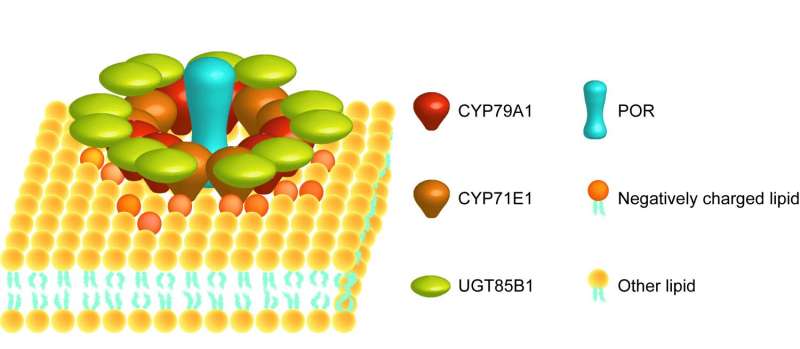November 18, 2016 report
Characteristics of a metabolon producing the defense compound dhurrin in sorghum revealed

(Phys.org)—An international team of researchers has uncovered the mechanism by which the sorghum plant uses the compound dhurrin to ward off pests and herbivores. In their paper published in the journal Science, the team describes their study, their results and the possible impact of their findings on the field of metabolon research. Mehran Dastmalchi and Peter Facchini with the University of Calgary offer a perspective piece on the work done by the team in the same journal issue, calling it a "watershed in metabolon research."
Prior research has found that the sorghum plant releases chemicals in response to attacks by plant eaters or pests—one such chemical, a substance called hdurrin, has been found to turn into cyanide when hydrolyzed. It is classified as one of a type of complexes known as metabolons, which are temporary complexes formed between enzymes in a metabolic pathway. They maintain their structure due to interactions between cell structures and membrane proteins present in the cytoskeleton. Unfortunately, the nature of metabolons is still not very well understood. In this new effort, the researchers sought to learn more about the general nature of such complexes by studying what happens when sorghum plants are attacked.
The team used a recently developed technique that involved the use of styrene maleic acid copolymer and affinity chromatography to obtain lipids along the endoplasmic reticulum which allowed them to isolate dhurrin samples. This allowed them to identify four of the players involved in converting an amino acid to dhurrin. One of them, they found, was a protein that served as an electron donor; two others were proteins that triggered the process, and the fourth was an enzyme that helped the other transactions take place. All four proteins performed in concert, they noted, to convert an amino acid called L-tyrosine to dhurrin. They also found that the membrane itself was actually a critical part of the metabolon character.

Dastmalchi and Facchini note that in addition to offering new insights into how dhurrin is converted to cyanide, the team perhaps more importantly revealed the major role that the endoplasmic reticulum plays in the process and in the workings of metabolons in general.
More information: T. Laursen et al. Characterization of a dynamic metabolon producing the defense compound dhurrin in sorghum, Science (2016). DOI: 10.1126/science.aag2347
Abstract
Metabolic highways may be orchestrated by the assembly of sequential enzymes into protein complexes, or metabolons, to facilitate efficient channeling of intermediates and to prevent undesired metabolic cross-talk while maintaining metabolic flexibility. Here we report the isolation of the dynamic metabolon that catalyzes the formation of the cyanogenic glucoside dhurrin, a defense compound produced in sorghum plants. The metabolon was reconstituted in liposomes, which demonstrated the importance of membrane surface charge and the presence of the glucosyltransferase for metabolic channeling. We used in planta fluorescence lifetime imaging microscopy and fluorescence correlation spectroscopy to study functional and structural characteristics of the metabolon. Understanding the regulation of biosynthetic metabolons offers opportunities to optimize synthetic biology approaches for efficient production of high-value products in heterologous hosts.
Journal information: Science
© 2016 Phys.org



















